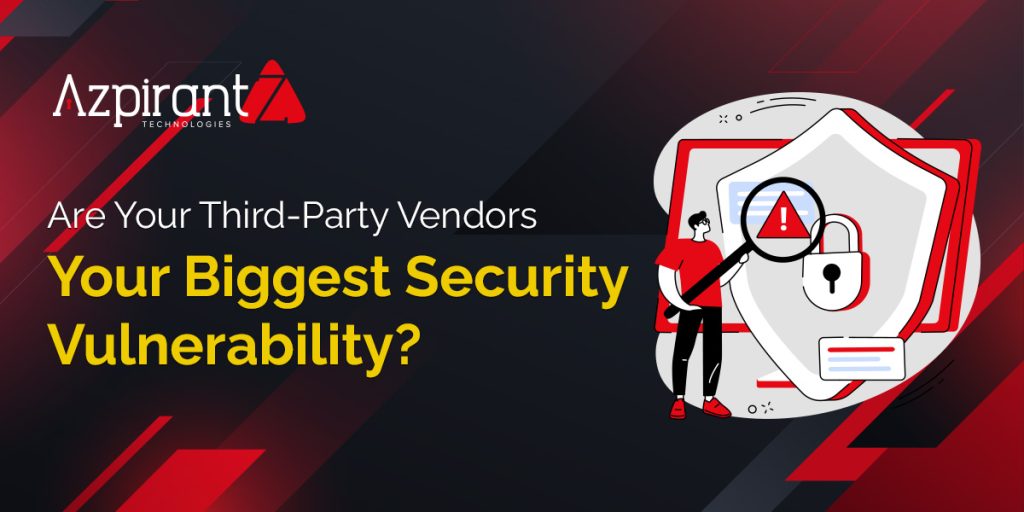Are Your Third-Party Vendors Your Biggest Security Vulnerability?
In today’s digital connected business landscape, organizations depend heavily on third-party vendors to run operations smoothly. From cloud service providers ,software vendors to logistics and even facility management companies, vendors have become essential in delivering products and services.

But here’s the truth:
these partnerships can become your cybersecurity weakness.
It’s not normal to have internal security policies—firewalls, encryption, endpoint protection—and still suffer a data breach because a vendor left the backdoor open. A small open at their end could lead to significant data loss, business interruption, financial penalties, and long-term reputational damage at yours.
So, the question is not about whether you need vendors. It’s how well you manage the risks that brought by them.
Some real-world scenarios
A vendor whom you hired for marketing automation gets hacked, exposing your customer database.
- A trusted software vendor pushes an update without knowing of malicious code in it.
- Your cloud service provider who doesn’t meet regulatory standards, leaves you exposed to fines under GDPR, HIPAA, or India’s DPDP Act.
- A ransomware attack on a logistics vendor stops all your delivery process and causes chaos in your operations.
These aren’t isolated—they’re reflecting of a growing trend of supply chain attacks that exploit the outside your direct control.
This is where ISO/IEC 27001 enters.
ISO 27001 is the global standard for establishing an Information Security Management System (ISMS). While many organizations associate it with internal security controls, it also offers guidance for managing third-party risks—turning your weak links into strengths.
Real-world steps guided by the principles of ISO 27001
- Begin with a Solid Risk Assessment
ISO 27001 encourages organizations to start with a simple but powerful question:
“What are the risks to my information, and where exactly are they coming from?”
When vendors are involved, it means going beyond the surface. You need to understand
- What kind of data or systems they can access,
- How well they’re protecting that data, and
- What the consequences might be if their security fails.
It is not enough to just ask, “Are you secure?” Instead, you need to do evaluation on how much risk each vendor brings—and whether your organization is prepared to handle it.
- Do Your Due Diligence Before You Sign Anything
Vendor selection should not just be about cost, convenience and speed. According to ISO 27001, due diligence is a non-negotiable step. That includes:
- Check if they are having ISO 27001, SOC 2, or other third-party validations?
- Check if their security practices are aligned with your security practices
- Check whether they can detect an attack quickly
- Check whether your security expectation clearly outlined in your contract details
This isn’t just practice—it’s your legal and operational insurance.
- Don’t Stop After Onboarding—keep the checks going
Many companies make the mistake of stopping vendor assessments after the initial agreement. ISO 27001 reminds us that risk is not static.SO we need to establish routines. This includes:
- Conducting regular audits or assessments
- Requesting periodic security reports or certifications
- Keep communication lines open in case of incidents or changes in their security posture
Think of your vendor relationships as ongoing partnerships, not one-time transactions.
- Prepare for the Worst—Before It Happens
Even with good secuirty controls, things can go wrong. ISO 27001 requires organizations to have a defined incident response plan that includes vendor-related issues.
Critical questions like:
- Who contacts whom in case of a breach?
- What information should be communicated to customers or regulators?
- How fast can you change vendors or activate backup services?
If vendor goes down, your business does noat have to go with it.
- Commit to Continuous Improvement
The cybersecurity threat landscape is constantly evolving with new threats, technologies, and regulations. ISO 27001 promotes a culture of continuous improvement, where vendor risk management is regularly updated to reflect the current threat landscape.
This means:
- Evaluating Annual reviews of your third-party risk management
- Implementing Internal awareness programs to educate your teams
- Updating vendor policies based on emerging threats
In today’s digital world, you can’t run a business without third parties. But you can manage them proactively rather than reactively.
ISO 27001 provides more than just set of rules. It helps you embed security into your organization’s—including how you work with third party vendors. Even if you’re not pursuing formal certification, applying this framework can significantly reduce third-party risk and increase your confidence in those partnerships.
Modern cybersecurity is not about building walls—it is about securing connections. By building a vendor risk management program based on ISO 27001, you can:
- Build trust with customers and partners
- Strengthen compliance posture
- Improve operational resilience
- Avoid costly surprises
The weakest link doesn’t have to break the chain—unless you ignore it.
In an era of escalating cyber threats and stringent data protection, achieving ISO 27001 certification is more than compliance—it’s a strategic imperative. For organizations seeking to significantly enhance their information security posture through a globally recognized standard, Azpirantz offers tailored ISO 27001 implementation consulting services. We partner with you to develop and integrate an effective ISMS, addressing supply chain risks, cloud security, and other critical vulnerabilities, helping you transform security into a competitive advantage for 2025 and beyond.
We're Here To Help